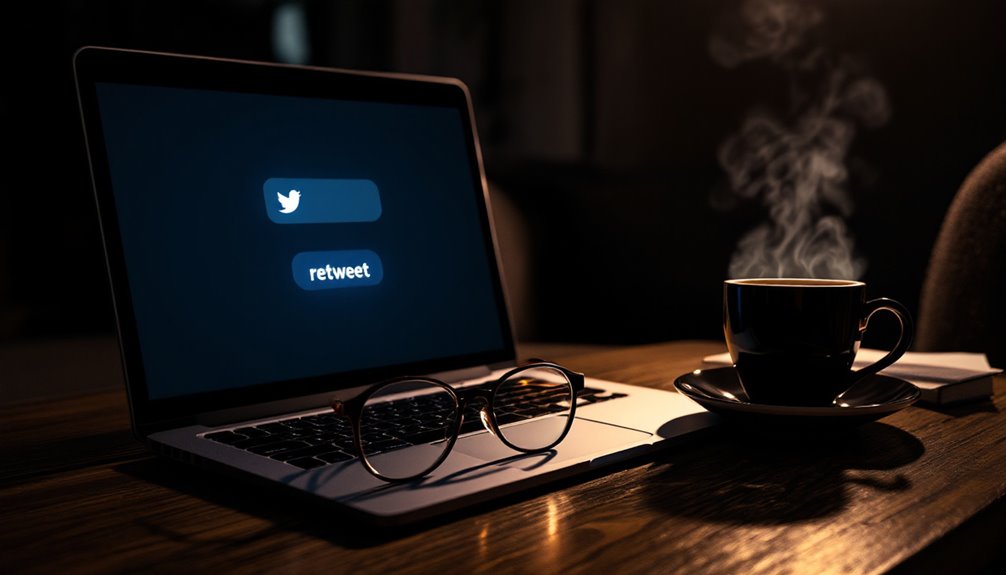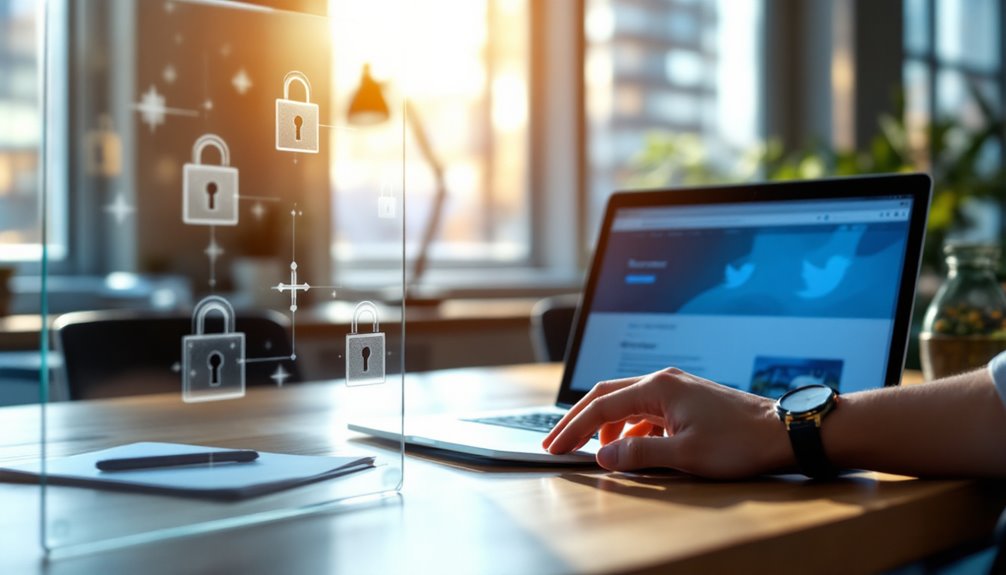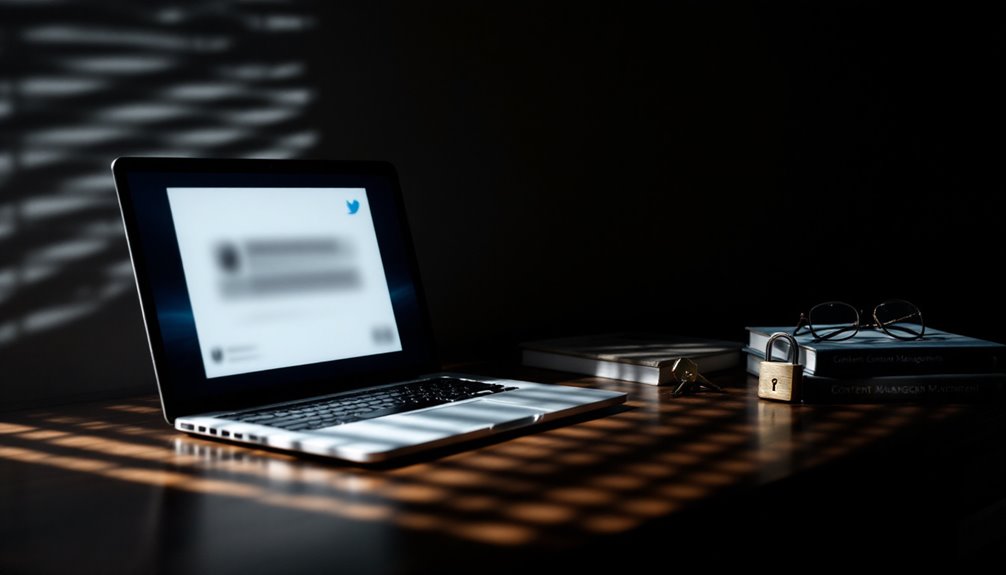
What is a private retweet?
Imagine a world where your tweets are guarded like treasures, shared only with a chosen few. That’s the essence of a private retweet, a feature that transforms how you engage on social media by allowing exclusive sharing with your followers. It’s not just about keeping things secret; it’s about maintaining control over who gets to see your retweets, fostering a more intimate connection with your audience. How does this impact your social media strategy and the way you interact online? Let’s explore the nuances and implications of this intriguing feature.
Key Takeaways
- Private retweets allow sharing with a private comment, similar to private messaging within a network.
- Only followers of the initiating account can view private retweets, ensuring enhanced privacy.
- They help maintain content exclusivity by preventing unwanted sharing and protecting brand integrity.
- Private retweets are useful for managing retweet strategies without losing content control.
- They enable selective interaction with tweets, enhancing engagement with a chosen audience.
Understanding Private Retweets

Understanding private retweets on X, formerly Twitter, begins with recognizing their unique functionality.
These retweets allow you to share someone else’s tweet with a private comment, functioning much like private messaging within your network. Unlike public retweets, these are confined to a select audience, enhancing targeted audience engagement. This feature is particularly useful when interacting with tweets from protected accounts, ensuring that the content remains exclusive to followers while facilitating a more intimate dialogue. Private quote retweets aren’t visible on the public timeline, a fact that underlines their specialized role in maintaining privacy. Only those who follow the account that initiated the private retweet can see these interactions. These retweets are often used to explore personal expression without seeking external validation, making them a popular choice for those who value discretion.
This limitation can be circumvented using external tools like Quoted Replies, which lets you view all quoted retweets, including private ones, by simply pasting a tweet link into the app or tagging @QuotedReplies on X.
The implications of this feature are profound. While it allows you to engage with content discreetly without public endorsement, it also highlights privacy challenges, as third-party tools can expose these interactions.
Consequently, private retweets balance personal engagement with the need for privacy.
Role of Protected Accounts
You’re in control of your tweet visibility with protected accounts, ensuring only approved followers access your content. Data shows that account owners manually approve new followers, limiting audience reach but enhancing privacy. This selective audience management means your tweets won’t appear in search engines, maintaining a high level of confidentiality. Protected Tweets provide privacy similar to private Facebook profiles, giving users more control over their social media interactions.
Privacy and Visibility Control
When you switch your Twitter account to protected, a significant change in privacy and visibility control occurs. With protected accounts, your tweets enjoy private visibility, ensuring only your approved followers can access them. This offers a robust layer of audience control, allowing you to dictate who views your content, an essential feature for users prioritizing online privacy. Protected accounts require new followers to undergo manual approval, reinforcing the selectivity of your audience. Once protected, your tweets won’t appear in search engines, making them immune to public scrutiny. Previously public tweets transform into private posts, no longer searchable by the general public. This alteration underscores the power you hold over your digital footprint. Engagement restrictions further enhance privacy. Followers can’t retweet your content; they can only favorite your tweets. This limits the dissemination of your posts, ensuring they remain within your chosen circle. For users seeking enhanced privacy, protected Tweets restrict visibility to followers only. Private quote retweets are invisible to non-followers, secured behind a digital wall only third-party tools can penetrate. By controlling who can see and interact with your tweets, protected accounts empower you to curate your digital presence, aligning with a forward-thinking approach to online privacy and security.
Selective Audience Management
Switching your account to protected mode shakes up how you manage your audience on Twitter, giving you unparalleled control over who sees your content. This feature allows only approved followers to access your tweets, which means you can tailor your audience engagement by selectively approving new followers.
This method of audience segmentation becomes a critical part of your content strategy, enabling you to share your ideas with a more controlled and intimate group, while keeping your tweets out of search engines and third-party sites. Protected accounts greatly impact audience engagement metrics. While the viral potential of your tweets is reduced since retweeting is disabled, the interactions you do have are with followers you’ve chosen. This means your community can be more engaged and interactive, though smaller.
For campaigns and marketing strategies, understanding the implications of protected tweets is essential. You won’t reach the broader public without manual approval, so your content strategy must adapt to this exclusivity. Tailored audiences, such as negative audiences, can be used in conjunction with protected accounts to enhance brand awareness by excluding previous visitors and focusing on new potential followers.
While your marketing reach might narrow, you gain a more focused audience that’s genuinely interested in your content, requiring innovative approaches to leverage this dynamic effectively.
Visibility and Privacy

When you switch to a private account, your retweets reach only approved followers, considerably limiting their audience.
Data shows that protected tweets don’t appear in public timelines or search results, offering a controlled content-sharing environment.
However, tools like Quoted Replies can bypass these limitations, revealing the complexities of maintaining true privacy online. Private accounts restrict tweet visibility to approved followers only, providing anonymity and control over online visibility.
Limited Audience Reach
Private retweets on X (formerly Twitter) are governed by specific privacy settings that limit their audience reach, focusing on visibility and privacy. When your account is protected, only approved followers can engage with your tweets, including retweets. This limited audience reach requires a thoughtful content strategy to maximize audience engagement within your circle.
Unlike public tweets that benefit from likes, replies, and hashtags to boost visibility, protected tweets remain insulated from these mechanisms. Protected accounts guarantee that your content doesn’t appear in external search engines or public timelines. This privacy level is crucial if you’re prioritizing control over who sees your interactions. It’s important to note that impressions from these protected tweets indicate the total number of views, not unique views, which means a smaller audience will likely result in lower overall impressions.
However, it also means your retweets won’t reach a broader audience, challenging traditional strategies aimed at viral growth. In this scenario, audience engagement becomes more personal and targeted, demanding innovative approaches to maintain connection within your approved network.
To further manage your content’s reach, third-party tools can track who’s quoting or retweeting your posts, even privately. These tools play a pivotal role in understanding how your audience interacts with your content, providing insights necessary to refine your content strategy and maintain meaningful engagement despite privacy constraints.
Controlled Content Sharing
Understanding the dynamics of controlled content sharing on X (formerly Twitter) is fundamental to balancing visibility and privacy. When you switch your account to private, your retweets, tweets, and comments are only visible to your followers. This controlled sharing guarantees that your content doesn’t appear in public searches or external platforms, like Google Search. Your audience engagement is limited to those who actively choose to follow you, fostering a more intimate interaction.
It’s important to recognize how privacy settings impact content visibility. Once your account is private, followers can’t use the Retweet icon to amplify your content, maintaining a closed-loop of information. This control over your digital presence empowers you to decide who engages with your content. However, it also limits your reach, as only your followers can see your tweets and retweets. Having full control over your content creation, like choosing what to post, can complement this privacy strategy by ensuring that what you share aligns with your goals.
Being proactive with your privacy settings is essential for effective controlled sharing. Adjust these settings to dictate who can view and interact with your content.
Benefits of Private Retweets
A significant advantage of private retweets is the enhanced privacy and control it offers users over their content. By disabling retweets, you can prevent unwanted sharing, thereby maintaining content exclusivity and protecting sensitive information. This feature allows you to strategically implement engagement strategies where you decide who interacts with your tweets. Private retweets can be particularly useful when integrating tools like Buffer for social media management, as it allows brands to manage their retweeting strategies effectively while maintaining control over their content. It’s a powerful tool to avoid unintended viral posts that mightn’t align with your intentions, ensuring that your audience only sees content meant for them.
Private retweets also play an important role in brand and content protection. They prevent unauthorized use or misrepresentation of your original posts, safeguarding the integrity of your message. For brands, this means you can manage your public image more effectively, keeping your intellectual property and proprietary content under control.
This approach not only preserves the original context but also enhances the perceived value of your content.
Moreover, while retweets are disabled, you still receive engagement through likes and comments. This enables you to gauge the impact of your content and receive meaningful feedback.
Information Diffusion Impact

Information diffusion on social media platforms like Twitter often exemplifies the rapid spread of content far beyond its initial audience. This phenomenon is largely driven by retweets, a powerful tool for information dissemination. A single retweet can extend a tweet’s reach to an average of 1,000 users, regardless of the original poster’s follower count. This amplifies audience engagement, as retweets create chains that propel content through networks swiftly, often occurring immediately after the first retweet.
Micro-influencers, particularly in regional crises, outperform larger influencers in effectively spreading information. Their localized influence guarantees essential updates reach affected areas quickly. Verified users and celebrities can also expedite information dissemination due to their extensive follower bases. However, human users generally have a greater impact than social bots, highlighting the importance of authentic engagement. During crises, digital influencers can significantly impact corporate brand reputation, illustrating their role in shaping public perception.
Content plays a vital role in retweet rates. Informational and humorous tweets tend to spread rapidly, and the strategic use of hashtags can further enhance visibility.
During large-scale events like elections or natural disasters, understanding the network dynamics and employing targeted audience engagement strategies can greatly affect how information diffuses, illustrating the nuanced interplay between content, influence, and connectivity.
Technical Considerations
Steering Twitter’s privacy settings offers users a range of options to control their content’s visibility and engagement. Guiding these settings allows you to protect your tweets, limiting visibility to approved followers. This technical constraint enhances privacy but also shapes the user experience by restricting how others interact with your content.
When you enable “Protect my tweets,” your tweets vanish from search engines and third-party sites, although Google may still have access to previously public posts. This guarantees your new protected tweets remain confined to a select audience.
However, technical constraints emerge with user interactions. Retweeting is disabled for protected tweets, restricting followers to favoriting your content without resharing it. This limitation preserves your content’s exclusivity but also impacts its reach and engagement potential. While you can still retweet public tweets from other accounts, your protected tweets and replies remain visible only to those you’ve approved. Current followers retain access to your profile and information even after privatization, ensuring that your privacy settings don’t disrupt ongoing connections.
Moreover, content accessibility is tightly controlled. Protected tweets don’t appear in public searches, archives, or contribute to public engagement metrics.
Although Twitter can’t control external sharing via screenshots, these technical considerations guarantee your privacy preferences are respected, enhancing your overall user experience.
Managing User Permissions

While understanding technical constraints is essential for maintaining privacy on Twitter, effectively managing user permissions plays a significant role in ensuring seamless control over social media accounts. By strategically assigning user roles and access levels, you can tailor permissions to meet the specific needs of your organization.
Different roles such as administrators, editors, content creators, and moderators hold distinct levels of access, allowing you to manage who can view or manage accounts. Administrators have the broadest capabilities, empowering them to delegate tasks and adjust user roles as necessary. As user numbers grow, manual permission assignment becomes time-consuming, highlighting the importance of utilizing centralized access management platforms.
Access permissions are pivotal in safeguarding your accounts, ensuring that only those with appropriate roles can make changes. For instance, social media managers might require full access, whereas interns could benefit from limited permissions.
Automating these permissions through centralized platforms streamlines management across multiple applications, enhancing efficiency and security.
Regularly reviewing permissions is vital to maintaining ideal access levels. As an administrator, you can create teams, manage users, and adjust channel settings to align with organizational needs.
This dynamic approach to user management fosters an environment ripe for innovation, allowing your team to leverage social media effectively while maintaining control and security.
Privacy and Security Features
Understanding the nuances of Twitter’s privacy and security features is essential for managing your social media presence effectively. When you activate the “Protect your Tweets” setting, you’re guaranteeing that your digital footprint is minimized, as your content remains visible only to approved followers.
This feature acts as a form of data encryption, safeguarding your tweets from appearing on third-party sites or search engines like Google. Consequently, your online interactions are controlled and secure, providing peace of mind in the ever-evolving digital landscape.
Private retweets from protected accounts are a confirmation of Twitter’s commitment to privacy. They don’t appear in public timelines or external searches, thereby restricting access to your content.
This selective visibility guarantees that only your followers, whom you’ve manually approved, can engage with your tweets. Such a system not only enhances data protection but also limits the spread of information to unintended audiences, reducing potential risks associated with oversharing.
Content Control and Management

In today’s digital ecosystem, effective content control and management are essential for maintaining a secure and engaging online presence. You’ll find that content moderation comes in various forms, each with unique benefits tailored to different online environments. Pre-moderation reviews content before it goes live, ensuring compliance with community guidelines and reducing the risk of inappropriate material. This type of moderation is prevalent on brand-managed social media, where maintaining quality is paramount. Alternatively, post-moderation allows for real-time interaction by publishing content immediately and reviewing it afterward. While this approach supports rapid engagement, it requires diligent monitoring to uphold community standards. Automated moderation leverages AI to efficiently process vast data amounts, offering a scalable solution for platforms like YouTube where speed and volume are critical. Distributed moderation empowers the community, enabling users to manage content through upvotes, downvotes, and reporting. This fosters trust and engagement, creating a self-regulating environment that aligns with community guidelines. Ultimately, the importance of content moderation lies in protecting user safety, fostering a positive atmosphere, and safeguarding brand reputation. With the number of social media users reaching 5.17 billion in early 2024, the role of content moderation in maintaining safe and respectful online spaces is more critical than ever.
















